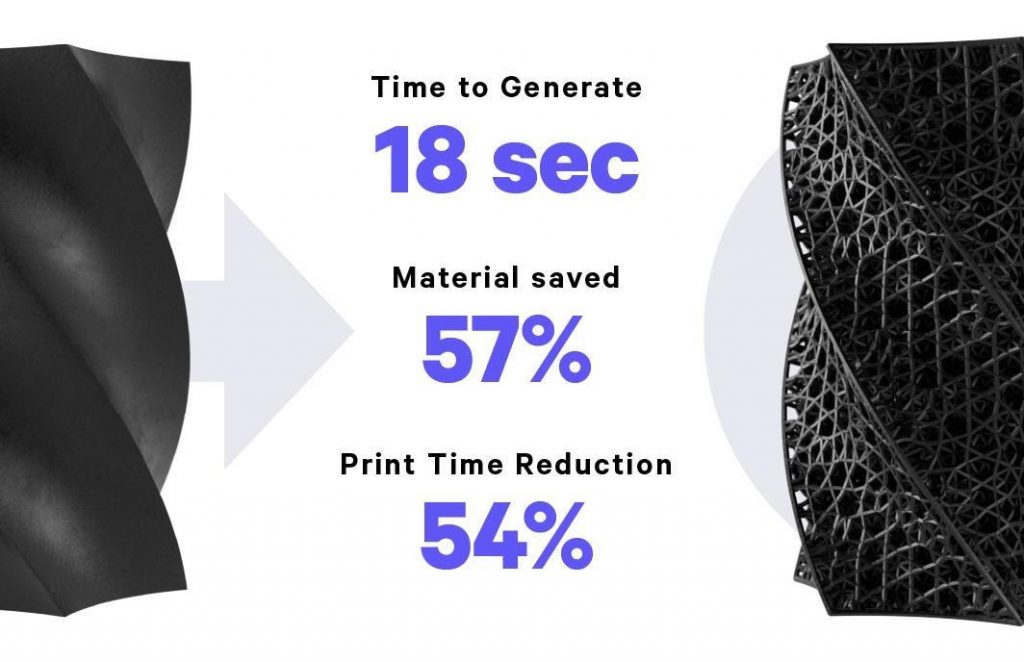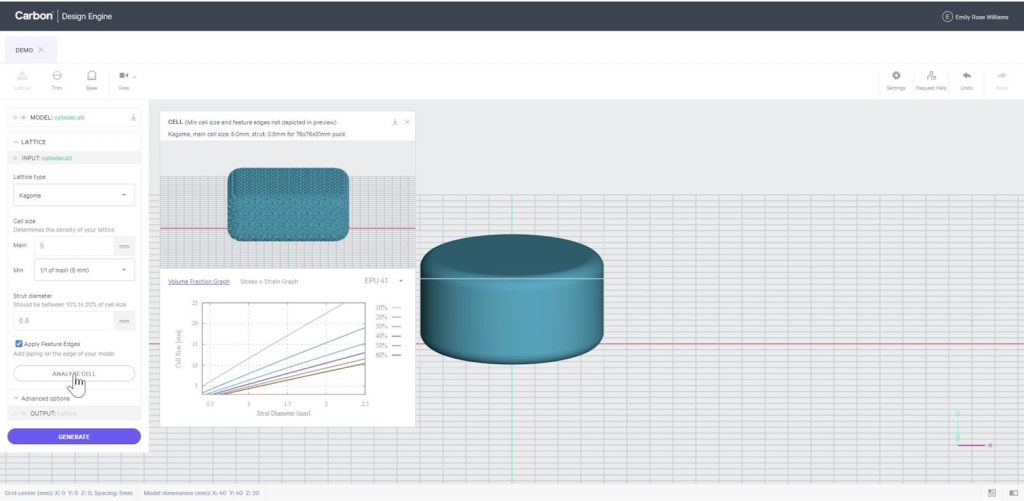Carbon, US manufacturers of the DLS 3D printing system, has announced that subscribers will now have access to an automated lattice generation tool.
I asked Phil DeSimone, Chief Product and Business Development Officer at Carbon, for more information about the newly available Design Engine.
Select customers have previously used carbon’s Design Engine to produce optimized products such as protective helmets for sport and COVID-19 testing swabs. Lattices can provide a high payoff between the often competing requirements of cost, strength, and weight. These complex structures are challenging, if not impossible, to make with traditional manufacturing techniques.
According to scientists at ETH Zurich, lattices “will be the design of choice” as 3D printing production volumes increase.
“Traditional CAD tools have not kept pace with the innovation of 3D printers and materials,” said DeSimone, Chief Product, and Business Development Officer. “On average, it can take 18-24 months to bring a consumer product to market. But when we put the best design tools, 3D printers, and materials in the hands of designers and manufacturers, we’ve seen our customers accelerate the development of innovative new products.”

3DPI: Can you tell us about any surprising applications of the lattice generation tool?
Phil DeSimone: Resolution Medical leveraged the Carbon Design Engine to produce a lattice swab during the sprint to offset the shortage of COVID-19 testing swabs (see here for more). Over the span of 20 days, the swab was prototyped, optimized with the Carbon Design Engine, produced, and in the hands of healthcare professionals.
Additionally, the software has been proven in production with the design of the Specialized S-Works Power Saddle with Mirror technology, the CCM Super Tacks X helmet, and Riddell football helmets.
3DPI: Is the release of this feature due to a push or pull, i.e., are many of your subscribers requesting this, or is the release something you are putting into the broader market for users to use AM in a more sophisticated manner?
Phil DeSimone: Carbon has been using this tool for many years to derive the applications mentioned above. There are currently no design tools out there that can help design engineers speed up the design process from production to market while saving time and effort. What we’re introducing with Design Engine is a democratized technology, where engineers can design products on the fly very quickly and take advantage of the DLS printer to make products that they couldn’t make before.
Carbon knew this before the pandemic, but it has become more clear to end-users: manufacturing and supply chains can’t afford to go back to pre-pandemic, antiquated methods of designing, producing, and distributing parts and products. Now that we’ve truncated the manufacturing piece with Carbon printers and materials, Carbon is on a journey to truncate the ‘idea to design’ side of the product development cycle. We are fulfilling a vision that has been talked about in the industry for years.
3DPI: Please can you quantify, probably with reference to a specific application/product, the cost and time savings, and the performance enhancement of using lattice designs from the Design Engine?
Phil DeSimone: Overall, The Carbon Design Engine™ generates lattices within 18 seconds on average, saves 57% more material, and reduces printing time by 54% on average (for more information, please see the images in the attached word doc). Additionally, this will have a 10x impact on the number of applications to discover.
3DPI: How does lattice generation using the Carbon Design Engine differ from lattices’ production with nTopology software?
Phil DeSimone: We, just as does nTopology, see an opportunity to accelerate the product design process. And, we hear from our customers that they are finding value in nTopology’s software.
Our product is valued for its dFAM features (printing and additive materials aware), its ability to conformally populate design spaces with a wide variety of strut and surface lattices specified by zone, transitions between zones, and features to tune performance around organic shapes (heads, feet, hands, etc.). Some of these features will be in future versions but have been used on public parts like Specialized Saddle, CCM Helmet, and others.
Use of Design Engine lattice generation by Carbon subscribers

Jeff Dalzell, Vice President of Product Creation at CCM Hockey, said, “Working with Carbon allowed CCM to leverage its innovation pipeline to launch something the industry had never seen before in the Super Tacks X helmet. Carbon technology has evolved, enriched, and accelerated our approach to product design allowing us to go from idea to production at record pace.”
“Within days of prototyping with the Design Engine, we gained creative insights into even more applications for performance-oriented lattices in our future product lines.”
“Carbon has exceptional materials and printers and now self-service design tools to take full advantage of it. It’s the perfect marriage of software, hardware, and materials,” said Dr. Jörg Gerken, Technical Director at rpm, a Carbon Production Network partner.
Carbon’s Design Engine currently can produce five types of conformal lattice. Other lattice generation options include the open-source Crystallon, a plug-in for Rhino and Grasshopper3D developed by Aaron Porterfield of FATHOM. In academia, the application of lattice structures to 3D printing has led to the novel projects such as this reconfigurable liquid metal lattice hand.
Lattice generation is set to be vital for expanding the adoption of 3D printing. Bradley Rothenberg, CEO and Founder of nTopology believes that engineering businesses will make approximately a third of industrial components with additive manufacturing in the next five years.
Today’s news from Carbon is another step along that path.
For all of the latest updates, subscribe to the 3D Printing Industry newsletter, follow us on Twitter and like us on Facebook.
Join 3D Printing Jobs to find your next opportunity.
Featured image shows an elastomeric lattice puck, designed with the Carbon Design Engine™ and printed with Carbon EPU 41 resin. Photo via Carbon.



